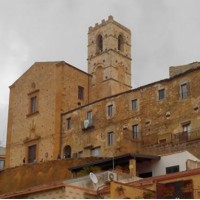Home - In and around
CHURCH OF SS. ANNUNZIATA (DEL CARMINE) PIAZZA ARMERINA ENNA
It was built in the thirteenth century by the Carmelite friars who, coming to Piazza, obtained by the municipality where the lot was already the church and the monastery of St. Lucia, converting it to the cult of St. Calogero Eremita.
Subsequently he was dwelling on dell'Altacura hill, where were the local headquarters of the Templars, giving birth to the new monastery dedicated to SS. Annunziata. Of dilapidated housing of the Knights of the Temple the tower are still visible (now the church tower) and stretches of walls built in the current complex, among which, the walls which still have walled portals of late Gothic style (first half of the thirteenth century).
The oldest part of the tower, that is, the first, second and third floor, was built by the Teutonic Knights Military, since there is carved above the entrance pointed portal their symbol; It shall refer at least to the first half of the thirteenth century, the date of construction of the tower, where the Order developed island in a large number of commanderies.
During the second half of that century the Teutons began a slow but continuous release policy with the transfer of real property; Reason for which the commendation dell'Altacura was sold to the Carmelites in search of safer places and healthier.
The presence of the Teutonic Order in Piazza Armerina is evidenced by other important documentation in reference to the presence of the Swabian house in Sicily under Frederick II.
Piazza Armerina became a sprawling place of such order in the nearby towns, it acquired many estates, and built numerous churches and commanderies.
Sources: A. Roccella
Subsequently he was dwelling on dell'Altacura hill, where were the local headquarters of the Templars, giving birth to the new monastery dedicated to SS. Annunziata. Of dilapidated housing of the Knights of the Temple the tower are still visible (now the church tower) and stretches of walls built in the current complex, among which, the walls which still have walled portals of late Gothic style (first half of the thirteenth century).
The oldest part of the tower, that is, the first, second and third floor, was built by the Teutonic Knights Military, since there is carved above the entrance pointed portal their symbol; It shall refer at least to the first half of the thirteenth century, the date of construction of the tower, where the Order developed island in a large number of commanderies.
During the second half of that century the Teutons began a slow but continuous release policy with the transfer of real property; Reason for which the commendation dell'Altacura was sold to the Carmelites in search of safer places and healthier.
The presence of the Teutonic Order in Piazza Armerina is evidenced by other important documentation in reference to the presence of the Swabian house in Sicily under Frederick II.
Piazza Armerina became a sprawling place of such order in the nearby towns, it acquired many estates, and built numerous churches and commanderies.
Sources: A. Roccella



